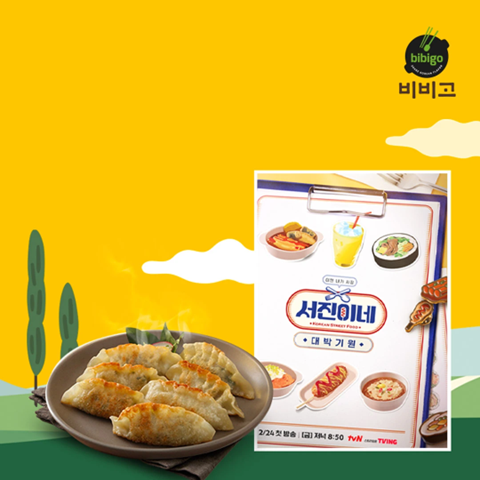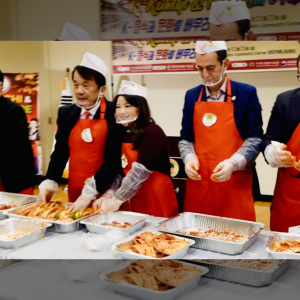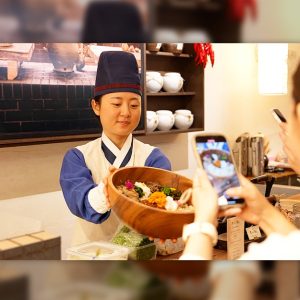Rice cake-based tteokbokki, as seen on “Jinny’s Kitchen,” is a spicy treat that’s simple to make at home.

Korean Classic Street Foods Come to Mexico
“Jinny’s Kitchen” – a popular new cooking show produced by CJ ENM – is bringing Korean street food to a relaxed town in the south of Mexico. Filmed near the picturesque Lake Bacalar, “Jinny’s Kitchen” features restaurant boss Lee Seo-jin in his efforts to win over Mexican customers with classic Korean street food dishes like gimbap (cooked rice rolls), mandu (fried dumplings) and gimmari (fried seaweed rolls).
Also featuring Jung Yoo-mi, Park Seo-joon, Choi Woo-shik and Kim Tae-hyung (aka V of BTS), the show has been a hit for global audiences and offers people everywhere a chance to learn more about K-food.
To celebrate “Jinny’s Kitchen” and its mission to introduce Korean foods to culinary enthusiasts around the world, this week CJ Newsroom explains how to make ‘tteokbokki,’ a spicy rice cake dish whipped up by the team in Episode 2.

What Is Tteokbokki?
Tteokbokki is a broth-based dish made with rice cakes (which are called ‘tteok’) found at restaurants and street food vendors alike. In “Jinny’s Kitchen,” Lee serves it up alongside fried mandu and gimmari, both provided by CJ CheilJedang’s global food brand bibigo.
Tteokbokki is surprisingly simple to cook. One key tteokbokki ingredient is gochujang (Korean fermented red chili sauce), so be sure to add bibigo Go-Chu-Jang to your shopping list for the perfect taste. For something to accompany your homemade tteokbokki, bibigo Mandu are an ideal addition to your authentic Korean spread.

Classic Korean Tteokbokki
Preparation
30 minutes
Cook Time
45 minutes
Serves
4
Ingredients
For the broth
8 cups of water
1 oz medium or large dried anchovies (can be replaced with vegetable stock if preferred)
6×6 inch dried kelp (aka ‘dashima’ – dried seaweed makes a good alternative if dashima is not available)
1 (6 oz) small onion, quartered
5 oz Korean radish, cut into small chunks
3 scallions (white parts, including roots)
For the tteokbokki
3 tbsp bibigo Go-chu-jang Sauce
3 tbsp gochutgaru (Korean red chili powder)
2 tbsp soy sauce
1 heaped tbsp garlic, finely minced
2 tbsp sugar (add more for extra sweetness)
2 tbsp rice syrup
24 oz fresh tteokbokki rice cakes, separated
1 rectangular sheet of Korean fish cake (aka ‘odeng’), cut into triangles similar in size to the rice cakes
Sesame seeds, to garnish
For the mandu (optional)
1 packet bibigo Mandu Pork & Vegetable
3 tbsp vegetable oil (if frying)
Directions
1. If refrigerated, pre-packaged rice cakes are being used, soak them in cold water for at least 20 minutes beforehand.
2. Combine all the broth ingredients in a large pot. Bring to boil, then reduce heat to medium-high and boil (with no lid) for 5 minutes. Remove the kelp, then continue to boil for 15 more minutes. Strain the broth into a large bowl and throw away the separated solids.
4. In a deep pan, add 4½ cups of the broth, along with the bibigo Go-chu-jang sauce, gochutgaru, soy sauce, garlic, sugar and rice syrup. Stir until they dissolve together.
5. Now add the pre-soaked rice cakes and bring it all to a boil over a medium-high heat. Cook for 7-8 minutes, with regular stirring.
6. Add the fish cake triangles. Keep cooking and stirring until the rice cakes are soft but still chewy, which should take roughly 5-6 minutes. As it cools, the sauce will get thicker. This is intentional, but if the sauce becomes too reduced a little water can be added. Taste and adjust with salt and sugar if needed.
7. The final dish can be served straight from the pan. Alternatively, move the tteokbokki onto a large platter. Add sesame seeds for garnish.
If adding bibigo Mandu
Mandu can be pan fried or steamed, depending on preference. Both versions go well with tteokbokki. Serve on a separate dish and dip into the tteokbokki sauce.
Pan fried: Pour 3 tbsp of vegetable oil into a nonstick pan. Arrange all the frozen mandu in the pan and space them out. Heat on medium-high heat for 8 minutes. Fry each side evenly for 2-3 minutes or until all sides are golden brown.
Steamed: Add water to a steamer and bring to boil. Place all the frozen mandu inside and steam for 8 minutes.











